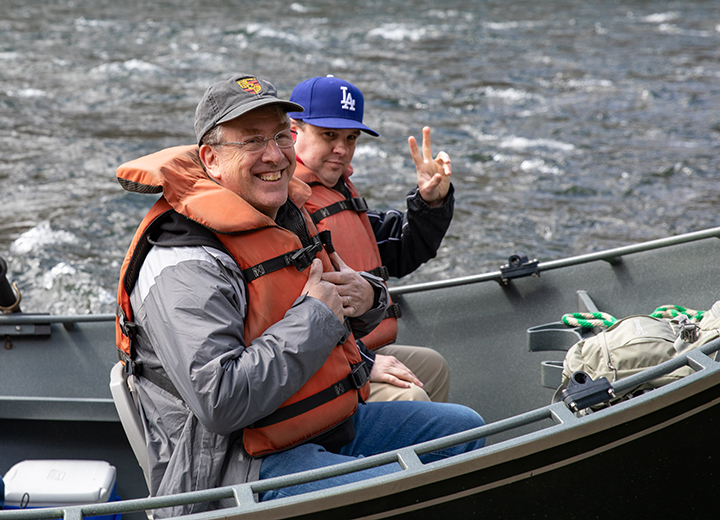Related News
Related News
-
Vote for your favorite Public Power Week Posters
The top five submittals will receive awards. Help us pick the winners.
Find Out More -
EWEB Hosts Annual Spill Drill to Protect McKenzie River
EWEB led emergency responders in its annual “spill drill” on the McKenzie River on Wednesday, Oct. 15, at the Trail Bridge Campground.
Find Out More -
A day in the life: Monitoring water quality throughout the McKenzie Watershed
Follow Senior Environmental Specialist David Donahue as he collects water quality samples from throughout the watershed as part of EWEB's early warning system for threats to Eugene's drinking water.
Find Out More -
EWEB Partners with Eugene School District 4J to Celebrate New Kennedy Middle School Emergency Water Station Site
Hundreds of attendees practiced filling up water containers at Saturday's demonstration event.
Find Out More -
EWEB general manager to retire in 2026
EWEB launches nationwide search for next leader to continue the progress of the last decade and ensure a smooth transition.
Find Out More -
EWEB statement on union complaints
EWEB is investigating concerns raised by the IBEW through a fair and thorough process.
Find Out More -
Quartz Creek: Setting the Stage for Floodplain Restoration
The project resets the floodplain along 1.8 miles of a formerly channelized creek to improve water quality, fish habitat and natural disaster resiliency.
Find Out More -
Pure Water Partners: 5 Years of Regeneration
As EWEB and the Pure Water Partners observe the fifth anniversary of the Holiday Farm Fire, we celebrate major milestones in the watershed's recovery and check back in with PWP landowners who still have a lot of work ahead as they continue to rebuild their lives.
Find Out More -
You can’t predict the next disaster, but you can prepare
The earthquake lasted less than a minute. But now the power’s out. The tap runs dry. Cell service is spotty. Would you be ready?
Find Out More -
Oregon’s New Utility Laws and How EWEB Customers Already Benefit from Fair, Transparent Rates
Oregon’s POWER Act and FAIR Energy Act target investor-owned utilities. Learn how EWEB’s local, community-owned model already meets these goals.
Find Out More -
EWEB Celebrates Operators on the 75th Anniversary of the Hayden Bridge Filtration Plant
Learn more about the Water Treatment Plant Operators who have kept the Hayden Bridge Filtration Plant running for the last 75 years.
Find Out More -
NASA partners with EWEB to assess wildfire impacts to drinking water
NASA's Earth Information Center shares a new video detailing how EWEB's Drinking Water Source Protection work is advising new research tools
Find Out More -
EWEB environmental specialist wins prestigious awards for publication
Article recounting EWEB’s efforts to protect the McKenzie River after Holiday Farm Fire earns national recognition
Find Out More -
Last Call for EWEB/Lane County Septic Grants
Holiday Farm Fire recovery program now eligible for businesses, residential property owners who purchased post-fire, to cover inspection costs and new construction
Find Out More -
Habitat Restoration Underway on McKenzie River
Partners at EWEB, McKenzie River Trust, the McKenzie Watershed Council, and the U.S. Forest Service broke ground on a major floodplain restoration project in Quartz Creek.
Find Out More - Show More
EWEB Commissioners, Eugene City Council Members Tour McKenzie River Restoration Projects
June 07, 2022

EWEB Commissioners joined Eugene City Council members and local leaders for a tour of McKenzie River restoration projects, coordinated by EWEB’s Source Water Protection team and our amazing collaborators at McKenzie Watershed Council (MWC), McKenzie River Trust (MRT), and the Willamette National Forest.
The tour focused on the coordinated response to the Holiday Farm Fire, emphasizing the effectiveness of large-scale floodplain enhancement projects for mitigating the impacts of sedimentation and increasing water temperatures.
Tour highlights included stops at Finn Rock Reach and the McKenzie River/South Fork of the McKenzie confluence. At these sites, EWEB, Willamette National Forest, McKenzie River Trust and McKenzie Watershed Council have installed massive projects aiming to restore the river to “Stage 0” conditions, referring to rivers’ natural tendencies to meander throughout a valley floor, to flood wetlands, to send water below the soils in some places (called “hyporheic flow”), and to slow down flows behind obstructions like logjams.
Rivers throughout the world have lost these natural conditions due to pressures from development, as we have altered and managed rivers to protect riverside infrastructure like roads and homes, and due to logging and mining. When the rivers lose their connection to the floodplain and are forced into a single channel, this creates a "firehose effect." The water loses the ability to spread out into the floodplain where the water slows down and drops out sediment and contaminants. Instead, the water flows through the channel at high speeds, carrying sediment and potential contaminants downstream where they can have huge impacts on personal property and infrastructure like roads and our water treatment plant.
By restoring Stage 0 floodplains throughout the McKenzie watershed, EWEB and our partners are restoring river and floodplain functionality to be a first line of defense against threats to drinking water quality. A healthier river can also slow down and store water/larger flow events, provide a haven for wildlife during fire event, and buffer metals, sediment and nutrient loads, and hazardous materials – reducing the work required of our treatment facility.
These projects also create new habitat for endangered salmon, bull trout, Pacific lamprey, and other species, empowering our watershed to protect itself against environmental stressors. In fact, in the first seasons after these projects were completed, redd (salmon nest) counts increased by as much as 20-fold!
“Thanks to all the people who are doing this incredible work, we are restoring and improving the watershed from hundreds of years of human impact,” EWEB Commissioner Sonya Carlson said after the tour. “Getting as close as we can to the natural flow of the waterway clearly has meaningful impact on the native species, our resiliency, and water quality.”
The Commissioners’ tour also visited the Finn Rock Boat landing, where the McKenzie River Trust is fundraising for major improvements, the confluence of Quartz Creek and the McKenzie River, where EWEB and partners are planning another floodplain enhancement project, as well as the former home of Barry Lopez. Lopez, an environmental author who was called a “modern day Thoreau,” lived on and wrote about the McKenzie River for 50 years. He passed away in December of 2020, but now his home serves as a writing retreat and a meeting place for the river conservation community.
Throughout the day, EWEB Commissioners, staff, and partners emphasized how these projects are possible thanks to the collaborative, multi-organizational approach to protecting our watershed and drinking water quality.
We are fortunate to have some of the cleanest drinking water in the country and EWEB's Source Water Protection Program is working to keep it that way. The program's successful track record over two decades enables us to collaborate with McKenzie valley landowners, leverage the diverse expertise of watershed partners, and attract funding support from state and federal sources while setting a national example of watershed protection.

